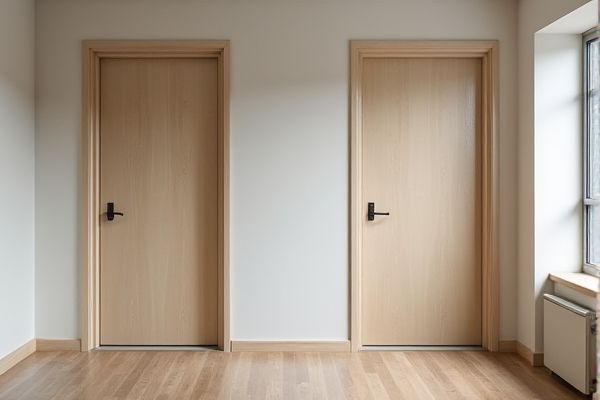
Lockers with doors provide enhanced security and privacy for your belongings, protecting them from dust and unauthorized access, while lockers without doors offer easier visibility and quick access, ideal for shared or frequently used spaces. Discover which locker type best fits your storage needs and environment by reading the full article.
Table of Comparison
| Feature | Locker with Door | Locker without Door |
|---|---|---|
| Security | Offers enhanced protection with lockable doors | Minimal to no security, open access |
| Privacy | Ensures contents are concealed | Contents visible and exposed |
| Ventilation | Limited airflow due to enclosed space | Optimal airflow, preventing odor buildup |
| Maintenance | Requires frequent cleaning to avoid odors | Easier to clean and maintain |
| Usage | Ideal for secure storage in schools, gyms, workplaces | Suitable for quick access and high visibility items |
| Durability | Doors may add weight and require hinges | Simpler design with fewer moving parts |
| Cost | Generally higher due to additional materials | Typically more affordable |
Introduction to Locker Types
Lockers with doors provide secure, enclosed storage that protects your belongings from dust, theft, and unauthorized access, making them ideal for environments requiring privacy and security. Lockers without doors offer open storage solutions for quick access and ventilation, commonly used in gyms or industrial settings where ease of use and airflow are prioritized. Choosing between these types depends on your need for security versus accessibility and breathability.
Overview of Lockers With Doors
Lockers with doors provide secure, enclosed storage spaces that protect contents from dust, theft, and damage, making them ideal for schools, gyms, and workplaces. These lockers often feature locking mechanisms such as key locks, combination locks, or electronic locks, enhancing security and privacy compared to open or doorless lockers. The enclosed design also helps maintain organization and conceal personal belongings, contributing to a cleaner and safer environment.
Overview of Lockers Without Doors
Lockers without doors provide open storage solutions that enhance visibility and airflow, making them ideal for environments requiring quick access and ventilation such as gyms, warehouses, and schools. These lockers often feature sturdy, durable frames crafted from metal or reinforced plastic, ensuring secure storage while minimizing the risk of odor buildup and moisture retention. Open locker designs prioritize convenience and ease of use, supporting organized storage without the need for additional door hardware or locking mechanisms.
Security Differences
Lockers with doors provide enhanced security by preventing unauthorized access and protecting your belongings from theft or damage. Lockers without doors offer less security, making stored items more vulnerable to tampering or accidental exposure. Choosing a locker with a door safeguards your valuables, ensuring your items remain confidential and protected.
Accessibility and Convenience
Lockers with doors provide enhanced security and privacy by fully enclosing contents, but may limit quick access due to door swing space and locking mechanisms. Lockers without doors offer rapid accessibility and easy visibility of stored items, ideal for environments requiring frequent item retrieval and monitoring. Choosing between the two depends on balancing the need for convenience against security and protection of personal belongings.
Privacy Considerations
Lockers with doors offer increased privacy by concealing contents, preventing unauthorized viewing, and providing a secure space for personal belongings. Lockers without doors expose items to public view, reducing privacy and increasing the risk of theft or tampering. Organizations prioritizing confidentiality and personal security typically prefer lockers equipped with doors for controlled access.
Durability and Maintenance
Lockers with doors typically offer enhanced durability due to their enclosed design, which protects contents from dust, damage, and environmental wear, extending the locker's lifespan. Without doors, lockers are more susceptible to scratches, rust, and physical impact, requiring more frequent maintenance and repairs. Your choice depends on whether you prioritize long-term durability and reduced upkeep or easier access and cost-effectiveness.
Cost Comparison
Lockers with doors generally incur higher costs due to additional materials such as hinges, locks, and door panels, which increase manufacturing and installation expenses. In contrast, lockers without doors offer a more budget-friendly option by eliminating these components, making them suitable for cost-sensitive environments like schools or gyms. Maintenance expenses also tend to be lower for doorless lockers, as they avoid issues related to door repairs and lock replacements.
Ideal Use Cases
Lockers with doors provide enhanced security and privacy, making them ideal for storing personal belongings in gyms, schools, and workplaces where confidentiality is important. Lockers without doors offer quick access and improved ventilation, suitable for environments like swimming pools or industrial settings where frequent use and air circulation are priorities. Your choice depends on balancing security needs with convenience and airflow requirements for the intended environment.
Choosing the Right Locker for Your Needs
Lockers with doors provide enhanced security and privacy, making them ideal for storing personal or valuable items in schools, gyms, or workplaces. Lockers without doors allow for quick access and better ventilation, suitable for environments where visibility and airflow are priorities. Selecting the right locker depends on balancing security requirements with accessibility and space considerations.
 homyna.com
homyna.com